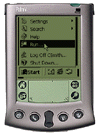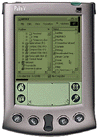



PalmVNC is a client for the Palm family of hand-held computers that provides remote access to your desktop PC, Mac, or UNIX workstation over a normal TCP/IP network connection.
For more information on VNC, see the VNC homepage.
PalmVNC was originally written by Vladimir Minenko, providing black-and-white access to your PC from the original Palm Pilot platforms (PalmOS versions 1.0 to 3.1).
Vladimir Minenko has kindly allowed Harakan Software to take over the development of the program, to exploit the functionality of the newer Palm models such as the Palm IIIc and Palm V series.
For the latest information, see the PalmVNC homepage.
The following PalmOS platforms are supported:
Click on an image for a larger version.
To install the PalmVNC client, simply double-click on the "PalmVNC.prc" file included in the distribution. This will cause the program to be installed on your Palm device the next time you hotsync.
To use PalmVNC, you must also have a VNC server installed on your desktop. To obtain a VNC server, see the VNC homepage. You must also have a working TCP/IP network connection between the Palm and the server.
If you are running WinVNC and wish to use the scaling functions provided in PalmVNC, follow these steps:
Note: The WinVNC server with scaling extensions requires more memory and has poorer performance than the standard WinVNC server. It is recommended that this server is NOT installed when sharing desktops or performing collaborative work.
Connecting
Before connecting, you must use the Preferences dialog to enter the name or IP address of your VNC server. You must also specify a display number (this is normally 0 for Windows servers).
Once you have set up your server properties, you can connect using the Open command on the Connect menu.
When you have finished, use Close to stop the VNC session, or Hang Up to stop the session and disconnect the modem.
Panning / Scaling
Once you have connected to the server, you will be able to see a portion of the desktop. To see more of the desktop, use the stylus to drag the black bar along the horizontal or vertical scrollbar. You can also use the Up, Down, Todo, and Memo buttons to pan up, down, left, and right respectively.
Use the View menu to scale the desktop. This requires a VNC server that supports the scaling extensions.
When using the Whole Desktop scale, tapping on the screen will zoom in on that point.
Mouse / Cursor Control
The stylus works like the left mouse button. Tap the stylus on the screen to single click. You can also double-click by tapping twice in rapid succession, or drag the stylus across the screen. Holding down the PhoneBook button will cause the stylus to act as the right mouse button. Hold down the DateBook button for the middle mouse button. It may be necessary to wait a few seconds after using the stylus before the screen is updated.
Text Entry
The Graffiti area may be used to enter text in the normal way, including the shift and shift-lock strokes. No shift state icon will be shown on the screen.
Special Functions
The Send menu allows certain special functions to be performed.
Special Keys
The "Special Keys" keyboard is a pop-up keyboard that will remain in the bottom-left of the screen, and allows keyboard controls to be used that are otherwise unavailable on the Palm.
To show the "Special Keys" keyboard, either use Special Keys on the View menu or tap the "abc" or "123" dots on the Graffiti area. Repeating this will hide the keyboard again.
The special keys work as follows:
All special keys will automatically be disabled when the keyboard is hidden, and re-enabled when the keyboard is shown again.
1. I tried running WinVNC, and got an error message "A required .DLL file, OMNITHREAD_RT.DLL, was not found.". Where is it?
You need to install the full WinVNC server from the VNC homepage before you can add the server extensions supplied with PalmVNC. See the Installation section for more details.
2. When I try to set the scale to anything but 1:1, I get a "Connection Lost!" message.
The server you are using does not support server-side scaling. You need to upgrade your server to one that includes server-side scaling to use this feature. Some clients (e.g. VNCViewer from WinVNC) support client-side scaling. The fact that these clients may work with your server does not indicate that the server has scaling extensions.
3. Why does the screen look garbled? I'm using a scale other than 1:1.
The most likely explanation is that your desktop is set to 256 colours. The scaling extensions assume that the desktop is in 15-bit colour or higher. Please set your desktop to a higher colour depth to correct this problem.
4. What are the recommended settings for my desktop to get the best out of PalmVNC?
The best settings to use for the desktop is 800x600 and 32-bit colour. This will give you a reasonable panning area and optimal server-side scaling performance. Higher resolutions tend to mean that you need to pan around the desktop too much.
5. PalmVNC is too slow. How can I make it faster?
The greatest effect on PalmVNC's performance tends to be the network bandwidth available. Therefore, the easiest way to make PalmVNC faster is to reduce the complexity of the display. The following hints will help to achieve this (in approximate order of effectiveness):
6. How do I set up a TCP/IP connection to my PC using the Palm cradle?
This is quite a complex issue, and has been discussed in a number of newsgroups and mailing lists. Some places to look for help for particular platforms:
Harakan Software makes no guarantees about the accuracy of these guides. Please search the websites and newsgroups or contact Palm Technical Support for more information.